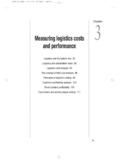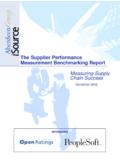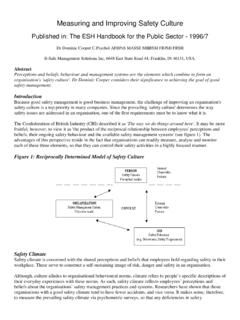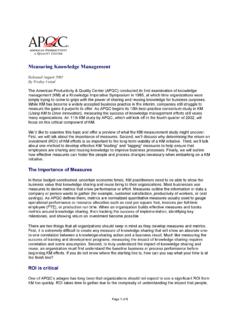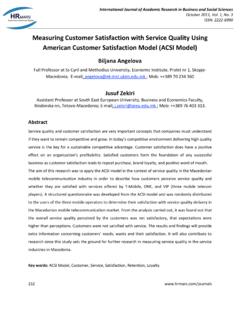Transcription of ManagingEnergy - ASHRAE Guideline 14
1 Of ASHRAE Guideline 14-2002(American Society of Heating, Refrigerating and Air-Conditioning Engineers)Measurement of Energy and Demand SavingsMeasurement of Energy and Demand SavingsMeasuring Energy SavingsTo assess the savings resulting from an Energy Conservation Measure Must be able to compare before and after energy use while also accounting for non-ECM factors. provides a user-friendlyinterface to comply with the Guideline , which isthe de-facto international Guideline 14-2002 Overview The purpose of ASHRAE Guideline 14-2002 is to provide guidelines for reliably measuring the energy and demand savings due to building energy management projects. measuring Energy SavingsThere are no direct ways to measure energy savings Instruments can only measure the presence of energy use and demandEnergy savings can only be determined indirectly The absence of energy use and demand can be calculated by comparing the energy use and/or demand from before and after the implementation of an energy conservation measure (ECM) ASHRAE Guideline 14-2002 Overviewimplementation of an energy conservation measure (ECM)
2 Statistical methods are used can be complexThis simple comparison does not differentiate between the energy impact of the ECM and other factors such as weather and occupancyMeasuring the impact of an Energy Conservation MeasureRequirements Must be able to project the energy use or demand patterns from the pre-retrofit (baseline) period into the post-retrofit period. Projection must take into account all major energy-governing Guideline 14-2002 OverviewMeasuring the impact of an Energy Conservation MeasureASHRAE Guideline 14-2002 OverviewApproaches for measuring Savings Circumstances suggest best optionASHRAE Guideline 14-2002 OverviewWhole Building Approach Uses a main meter to measure energy flow ECMs may be applied to one or more of the systems served by the meter Might involve the use of monthly utility bill data Option of two paths (prescriptive or performance)
3 Retrofit Isolation Approach Uses meters to isolate the energy use and/or demand of the subsystems affected by Uses meters to isolate the energy use and/or demand of the subsystems affected by the ECM pre and post-retrofitWhole Building Calibrated Simulation Approach Uses computer simulation software to model facility energy use and demand Model is calibrated against actual energy use and demand data Calibrated model is used to predict energy use and demand of the post-retrofit periodSelecting an ApproachASHRAE Guideline 14-2002 OverviewMost typical memethodApproaches: Common ConsiderationsASHRAE Guideline 14-2002 OverviewSelection of Relevant Independent Variables Variables which represent forcing functions of the energy-using system t-test should be used to determine which variables are significant The most significant variables should be measured over the period of interest Unaccounted for variables are the primary source of uncertainty in any computed savingscomputed savingsExamples of Relevant Independent Variables Weather (temperature, humidity, cloud cover and wind) Occupancy (floor area rented, sales, hotel vacancy rates) Production (items produced, shifts)Approaches.
4 Common ConsiderationsASHRAE Guideline 14-2002 OverviewDocumenting Baseline Conditions Changes in the design or use of the building may lead to an invalid/outdated baseline model Recording baseline conditions can aid in model revisions Common conditions include Occupancy patterns, densities, schedules, and type for each typical season. Average throughput or plant loads in each operating mode Average throughput or plant loads in each operating mode Operating schedules and key set points of energy-using systems for all operating modes Non-routine functions of the facility, their dates, and impacts on operation The nature and timing of any breakdown of significant energy-using equipment Equipment nameplate dataMeenergy auditing and document management features provide key process Building ApproachASHRAE Guideline 14-2002 OverviewThe Whole Building Approachencompasses procedures that verify the performance of retrofits where whole building pre- and post-retrofit data are available.
5 Appropriate for complex, multi-phase projects as opposed to one or two contained Building Approach: PathsASHRAE Guideline 14-2002 OverviewThere are two possible paths which can be takenWhole Building Prescriptive Path Expected Savings > 10% Energy data is continuous (no exclusions) in pre- and post-retrofit dataManaging Energy uses the Whole Building Performance PathWhole Building Performance Path Energy data is not continuous More forgiving of data availability Statistical methods assess validityNormal Baseline ModelASHRAE Guideline 14-2002 OverviewThe regression process yields a statistical model in the following formBaseline AdjustmentsASHRAE Guideline 14-2002 OverviewNeeded when changes to the facility occur during the post-retrofit 1 (preferred)
6 Sub-meter the effect if possible Post-retrofit data is then simply the total metered amount less the sub-metered quantityOption 2 Account for the adjustment in the modelManaging Energy supports option, with either an actual submeter or virtual (calculated) an Optimal Baseline ModelASHRAE Guideline 14-2002 OverviewThe Guideline recommends the optimal model be selected based on a measure of the goodness of fit. Indicates the proportion of response variation R : Coefficient of Determination Indicates the proportion of response variation explained by the regressors Indicates the uncertainty in the modelCV(RMSE): Coefficient of Variation of the Root Mean Squared ErrorIdentifying an Optimal Baseline ModelASHRAE Guideline 14-2002 OverviewR : Coefficient of DeterminationR = 1 All variability in the response variable can be explained by the regressors.
7 R = Approximately 80% of the variation in the in the response variable can explained by the regressors. R =0 None of the variation in the response variable can be explained by the regressors. No relationshipR=Ideally you want R > NOTE: Correlation does not imply causation Identifying an Optimal Baseline ModelASHRAE Guideline 14-2002 OverviewCV(RMSE): Coefficient of Variation of the Root Mean Squared Error A measure of uncertainty in the model Whole Building Prescriptive Path CV(RMSE) < 20% for energy use CV(RMSE) < 30% for demandPost-Retrofit Period < 12 monthsManaging Energy supports CV(RMSE) < 25% for energy use CV(RMSE) < 35% for demandPost-Retrofit Period 12 60 months CV(RMSE) < 30% for energy use CV(RMSE) < 40% for demandPost-Retrofit Period > 60 monthsManaging Energy supports the Whole Building Performance Pathbut CV(RMSE)
8 Can be used interchangeably with R Identifying an Optimal Baseline ModelASHRAE Guideline 14-2002 OverviewA well correlated model is not always a good model Compliance indicators can be helpful in assessing whether a model is soundmanagingenergy provides a quick compliance check in the modeling viewCompliance: CV(STD) ASHRAE Guideline 14-2002 OverviewCoefficient of Variation of the Standard Deviation Another measure of model uncertainty Used to compute savings uncertainty when the baseline energy use or demand is essentially the same in all periodsCompliance: NMBEASHRAE Guideline 14-2002 OverviewNormalized Mean Bias Error Yet another measure of model uncertainty A compliance criteria for the Whole Building Simulation ApproachCompliance: Net Determination BiasASHRAE Guideline 14-2002 OverviewDefinition The net determination bias test shall apply the baseline independent variable data to the algorithm for savings determination to re-compute an algorithm-determined baseline energy usage or demand for each of the nbaseline data points (i).
9 These re-computed quantities are then compared to the actual baseline energy usage or demand (i) in the baseline period to derive the net determination period to derive the net determination comply with the Guideline : net determination bias : Net Determination BiasASHRAE Guideline 14-2002 OverviewCompliance: Includes All Operating ModesASHRAE Guideline 14-2002 OverviewBaseline periods, which span all modes of system operation are needed to reduce uncertainty in computed savings A facility which operates on a annual cycle in response to weather should have a baseline period of a least one full year Period immediately prior to retrofit is preferred Operations are most likely representative of post-retrofit period Easily remembered by facility staff and thus least likely to introduce bias or Easily remembered by facility staff and thus least likely to introduce bias or error due to unaccounted significant variablesManaging Energy determines if the baseline model contains data from each month of the.
10 Balanced RepresentationASHRAE Guideline 14-2002 OverviewCare should be taken to ensure all modes of system operation are represented equally. Failure to do so may result in over representing one operational mode and thus introducing bias into the model ( summer months than winter months) Most easily achieved by using an integral number of continuous 12 month periods ( 12, 24, 36 months), not partial years ( 7, 15, 30 month periods ( 12, 24, 36 months), not partial years ( 7, 15, 30 months)Managing Energy computes the amount of data within each of the 12 months and ensures that all months are approximately : Balanced RepresentationASHRAE Guideline 14-2002 OverviewCompliance: Balanced RepresentationASHRAE Guideline 14-2002 OverviewWinter months are now over-representedrepresentedCompliance.)

